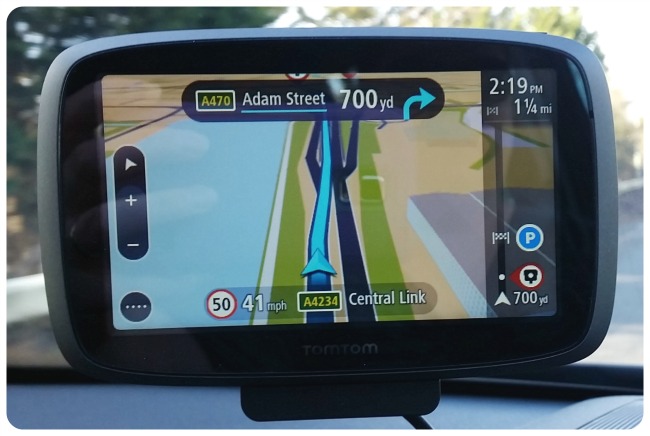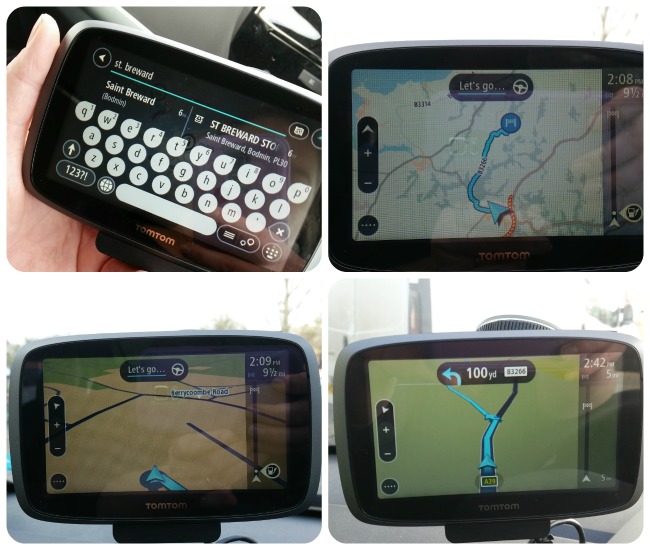When it comes to navigation whilst driving, I am resolutely an advocate of reading road signs and maps, using the internal compass, asking directions and working out the way to go next using all these skills. I can't tell you how many times my husband and I have rowed during a car journey because he has relied solely upon the satnav function on his phone and ignored his common sense of road signs!
So I'd make a good person to review a TomTom then wouldn't I?
Turns out, I am actually!

We first put the TomTom to good use when we went to a part of Cornwall we'd never visited before in February half-term, south Cornwall is a complete mystery to me and the roads can very quickly turn from a dual carriageway into a lane in the middle of nowhere! The Maps app on our phones doesn't always work in rural areas so the TomTom was going to save a lot of time and worry. And arguments!
The TomTom Go 5000 can be charged and retain battery life for a shorter journey, but we did have to plug it in for the 3.5 hour journey down there. The map takes up the vast majority of the screen, and was exceptionally easy to read when driving, even automatically switching to a dimmer colour scheme later in the day. Once we were in Cornwall, we weren’t in enough of a built-up area to check the 3D building models, however the angle of display of the map was just right to show enough of the route ahead.
At the base of the map the TomTom displays both the current speed limit and the car’s speed, colour-coded to indicate to the driver that they may be speeding. Together with the warnings of upcoming speed cameras this was an interesting feature, but we found that it occasionally misreported speed limits on B-roads and wasn’t aware of temporary speed limits or cameras within motorway roadworks.
However, by far the most useful feature on the TomTom was the Route Bar that forms the right-hand border of the screen. It’s designed to show a variety of upcoming items including traffic problems and points of interest, but with a small child our main use was to keep track of how near we were to the next service station!

While I'm quite good at navigating around my local area, there are some parts of Cardiff that remain a complete mystery to me! I can visualise the place I want to be, but for some areas I can't visualise the route I need to take. I've used the Maps app on my phone before but it's not ideal; it's either balanced on my knee so I can hear it which isn't safe, or it's on the seat next to me and I can't hear it. Either way, I definitely can't see it!
Fixing the TomTom to the screen is definitely easier and the sound is good enough to be heard over a chattering five year old child in the back! I used it recently when I was trying to find the venue for the blogging conference I was organising in the heart of studentville in Cardiff; one of those classic situations where I couldn't work out how to get there try as I might. The TomTom guided me right to the door with minimal effort and stress, the route bar on the right of the screen was particularly useful so I could anticipate lane changes based on left or right turns.
So what makes the TomTom better than an app on my phone? The fact that it has significantly more information, can be fixed to the screen (and removed easily), the volume, the route bar, the up-to-date information concerning traffic and roadworks, and the general ease of use.
Am I convert? Absolutely! Don't get me wrong, it is not something that I will be using all the time because I still think map-reading is an important skill, but I'm a busy mum and I don't always have time (especially when I'm the only adult in the car) to keep pulling in and checking the map. The TomTom suits a busy lifestyle very well!
—
I was sent this product for the purpose of this review, my opinion is honest and unbiased. I also didn't take the photos whilst driving, that was the passenger's job!


Leave a Reply